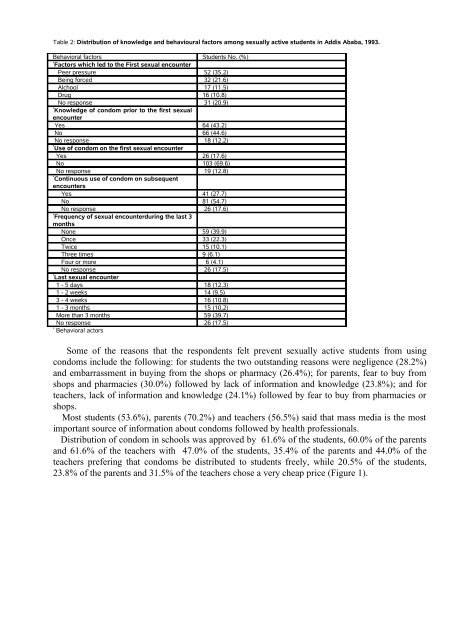Original article - Ethiopian Review
Original article - Ethiopian Review
Original article - Ethiopian Review
- No tags were found...
Create successful ePaper yourself
Turn your PDF publications into a flip-book with our unique Google optimized e-Paper software.
Table 2: Distribution of knowledge and behavioural factors among sexually active students in Addis Ababa, 1993.Behavioral factors Students No. (%)* Factors which led to the First sexual encounterPeer pressure 52 (35.2)Being forced 32 (21.6)Alchool 17 (11.5)Drug 16 (10.8)No response 31 (20.9)*Knowledge of condom prior to the first sexualencounterYes 64 (43.2)No 66 (44.6)No response 18 (12.2)* Use of condom on the first sexual encounterYes 26 (17.6)No 103 (69.6)No response 19 (12.8)*Continuous use of condom on subsequentencountersYes 41 (27.7)No 81 (54.7)No response 26 (17.6)* Frequency of sexual encounterduring the last 3monthsNone 59 (39.9)Once 33 (22.3)Twice 15 (10.1)Three times 9 (6.1)Four or more 6 (4.1)No response 26 (17.5)* Last sexual encounter1 - 5 days 18 (12.3)1 - 2 weeks 14 (9.5)3 - 4 weeks 16 (10.8)1 - 3 months 15 (10,2)More than 3 months 59 (39.7)No response 26 (17.5)*Behavioral actorsSome of the reasons that the respondents felt prevent sexually active students from usingcondoms include the following: for students the two outstanding reasons were negligence (28.2%)and embarrassment in buying from the shops or pharmacy (26.4%); for parents, fear to buy fromshops and pharmacies (30.0%) followed by lack of information and knowledge (23.8%); and forteachers, lack of information and knowledge (24.1%) followed by fear to buy from pharmacies orshops.Most students (53.6%), parents (70.2%) and teachers (56.5%) said that mass media is the mostimportant source of information about condoms followed by health professionals.Distribution of condom in schools was approved by 61.6% of the students, 60.0% of the parentsand 61.6% of the teachers with 47.0% of the students, 35.4% of the parents and 44.0% of theteachers prefering that condoms be distributed to students freely, while 20.5% of the students,23.8% of the parents and 31.5% of the teachers chose a very cheap price (Figure 1).




![to read the full report [pdf, Amharic] - Ethiopian Review](https://img.yumpu.com/52737829/1/190x245/to-read-the-full-report-pdf-amharic-ethiopian-review.jpg?quality=85)











